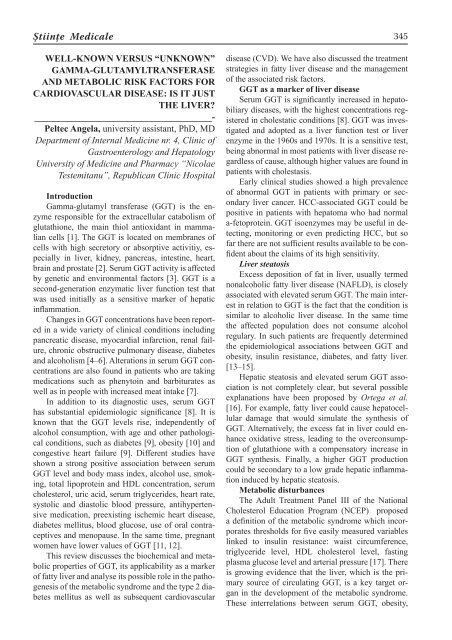2011, nr. 3 - Academia de ÅtiinÅ£e a Moldovei
2011, nr. 3 - Academia de ÅtiinÅ£e a Moldovei
2011, nr. 3 - Academia de ÅtiinÅ£e a Moldovei
Create successful ePaper yourself
Turn your PDF publications into a flip-book with our unique Google optimized e-Paper software.
Ştiinţe MedicaleWELL-KNOWN VERSUS “UNKNOWN”GAMMA-GLUTAMYLTRANSFERASEAND METABOLIC RISK FACTORS FORCARDIOVASCULAR DISEASE: IS IT JUSTTHE LIVER?______________________________________-Peltec Angela, university assistant, PhD, MDDepartment of Internal Medicine <strong>nr</strong>. 4, Clinic ofGastroenterology and HepatologyUniversity of Medicine and Pharmacy “NicolaeTestemitanu”, Republican Clinic HospitalIntroductionGamma-glutamyl transferase (GGT) is the enzymeresponsible for the extracellular catabolism ofglutathione, the main thiol antioxidant in mammaliancells [1]. The GGT is located on membranes ofcells with high secretory or absorptive activitiy, especiallyin liver, kidney, pancreas, intestine, heart,brain and prostate [2]. Serum GGT activity is affectedby genetic and environmental factors [3]. GGT is asecond-generation enzymatic liver function test thatwas used initially as a sensitive marker of hepaticinflammation.Changes in GGT concentrations have been reportedin a wi<strong>de</strong> variety of clinical conditions includingpancreatic disease, myocardial infarction, renal failure,chronic obstructive pulmonary disease, diabetesand alcoholism [4–6]. Alterations in serum GGT concentrationsare also found in patients who are takingmedications such as phenytoin and barbiturates aswell as in people with increased meat intake [7].In addition to its diagnostic uses, serum GGThas substantial epi<strong>de</strong>miologic significance [8]. It isknown that the GGT levels rise, in<strong>de</strong>pen<strong>de</strong>ntly ofalcohol consumption, with age and other pathologicalconditions, such as diabetes [9], obesity [10] andcongestive heart failure [9]. Different studies haveshown a strong positive association between serumGGT level and body mass in<strong>de</strong>x, alcohol use, smoking,total lipoprotein and HDL concentration, serumcholesterol, uric acid, serum triglyceri<strong>de</strong>s, heart rate,systolic and diastolic blood pressure, antihypertensivemedication, preexisting ischemic heart disease,diabetes mellitus, blood glucose, use of oral contraceptivesand menopause. In the same time, pregnantwomen have lower values of GGT [11, 12].This review discusses the biochemical and metabolicproperties of GGT, its applicability as a markerof fatty liver and analyse its possible role in the pathogenesisof the metabolic syndrome and the type 2 diabetesmellitus as well as subsequent cardiovascular345disease (CVD). We have also discussed the treatmentstrategies in fatty liver disease and the managementof the associated risk factors.GGT as a marker of liver diseaseSerum GGT is significantly increased in hepatobiliarydiseases, with the highest concentrations registeredin cholestatic conditions [8]. GGT was investigatedand adopted as a liver function test or liverenzyme in the 1960s and 1970s. It is a sensitive test,being abnormal in most patients with liver disease regardlessof cause, although higher values are found inpatients with cholestasis.Early clinical studies showed a high prevalenceof abnormal GGT in patients with primary or secondaryliver cancer. HCC-associated GGT could bepositive in patients with hepatoma who had normala-fetoprotein. GGT isoenzymes may be useful in <strong>de</strong>tecting,monitoring or even predicting HCC, but sofar there are not sufficient results available to be confi<strong>de</strong>ntabout the claims of its high sensitivity.Liver steatosisExcess <strong>de</strong>position of fat in liver, usually termednonalcoholic fatty liver disease (NAFLD), is closelyassociated with elevated serum GGT. The main interestin relation to GGT is the fact that the condition issimilar to alcoholic liver disease. In the same timethe affected population does not consume alcoholregulary. In such patients are frequently <strong>de</strong>terminedthe epi<strong>de</strong>miological associations between GGT andobesity, insulin resistance, diabetes, and fatty liver.[13–15].Hepatic steatosis and elevated serum GGT associationis not completely clear, but several possibleexplanations have been proposed by Ortega et al.[16]. For example, fatty liver could cause hepatocellulardamage that would simulate the synthesis ofGGT. Alternatively, the excess fat in liver could enhanceoxidative stress, leading to the overconsumptionof glutathione with a compensatory increase inGGT synthesis. Finally, a higher GGT productioncould be secondary to a low gra<strong>de</strong> hepatic inflammationinduced by hepatic steatosis.Metabolic disturbancesThe Adult Treatment Panel III of the NationalCholesterol Education Program (NCEP) proposeda <strong>de</strong>finition of the metabolic syndrome which incorporatesthresholds for five easily measured variableslinked to insulin resistance: waist circumference,triglyceri<strong>de</strong> level, HDL cholesterol level, fastingplasma glucose level and arterial pressure [17]. Thereis growing evi<strong>de</strong>nce that the liver, which is the primarysource of circulating GGT, is a key target organin the <strong>de</strong>velopment of the metabolic syndrome.These interrelations between serum GGT, obesity,
















